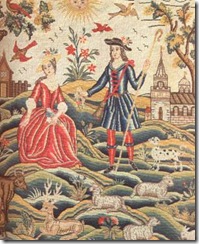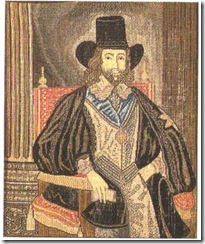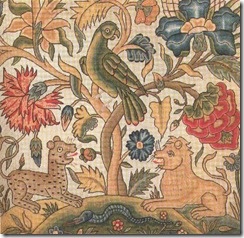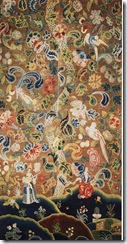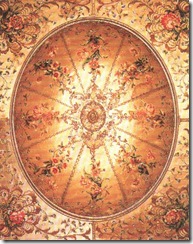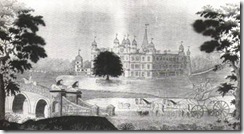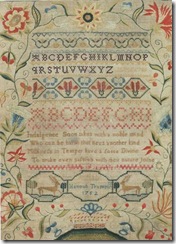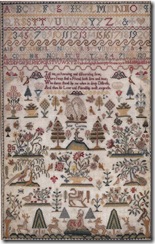The Kings & Queens Ascended to the throne
Stuart Kings (continued)
Anne 1702
Hanover to Windsor
George I 1714
George II 1727
George III 1760
Following the Act of Succession – where no catholic could inherit the throne – the succession passed to the Hanover kings. During George I’s reign the court was almost non-existent except as a social forum. George I was renown for his mistresses and his hostility with his son and heir apparent. George I was a lazy king who left much policy decision to the ministers of the day. Like his father George II was a German price and not too bright. George III saw the American war of Independence (1775-1783). And the population of England doubled. Transport was revolutionised with new roads, tramways and the first canals. The improvement in infrastructure inevitably led to the fashions and embroidery of the day filtering down from London much more quickly and it was much easier to travel to London to buy or commission goods.
Early eighteenth century outfit of petticoat, waistcoat and stomacher. Embroidered in silk and gold thread on a quilted ground.
At the beginning of the eighteenth century Parliament attempted to curb the import of materials from China, Persia and the East Indies as these threatened the prosperity of English industry. These restrictions were relaxed in 1736 but in 1749 metal thread embroidery, lace and fringes were forbidden.
Mantua court dress from the 1740’s embroidered with silver thread on silk.
Women had three basic choices of dress during the eighteenth century. The first was a closed robe or gown. The second an open robe worn with a petticoat and a separate stomacher. The gown could be fitted or fall into folds from the shoulders. The third option was a bodice and skirt.
Left, part of a set of silver lace robings c1750. Right, a stomacher from the first half of the century embroidered with silver thread and silks.
Eighteenth century designs in embroidered and woven silks often contained complex flower motifs. The wide-hooped petticoats of the time allowed large scale patterns to be displayed. Quilted petticoats also became a decorative item.
Quilted white satin travelling petticoat made between 1745 and1760.
Detail of an apron made between 1702 and 1714. The ivory silk ground is embroidered with flowers and the scalloped edges have gold thread.
Male dress of the time consisted of a frock coat, waistcoat and breeches. Men’s clothing was highly decorates with embroidery from 1760 onwards and was influenced by the art and costume seen on the “Grand Tour”.
Detail from a court coat of the 1770’s. The coat is heavily embroidered to imitate a lace pattern.
During the eighteenth century many silk fabrics were not embroidered but were woven with patterns and brocaded. London weavers were based at Spitafields and import taxes on foreign silks were introduced to protect the English silk trade.
Detail of a pocket from a 1780’s court coat.
Silk embroidery with sequins and spangles.
The late eighteenth century saw the introduction of printed cottons. The development of industrial spinning and weaving machines in large mills supplied affordable cotton cloth that was often block printed. For the first time ordinary people were able to chose from a wide variety of fabrics which were often beautifully coloured and patterned and available at affordable prices.
Metal threadwork became fashionable and “purl” was widely used and continued to be fashionable throughout the eighteenth century. The use of jewels declined.
After the seventeenth century the development of domestic English needlework changed from an emphasis on children’s work, pictures and caskets to canvaswork. More often needlework was for covering furniture.
Early eighteenth century wing chair.
Designs were based on a wide range of subjects; classical and biblical stories, mythology, fables chinoiserie etc. Towards the end of the C18th canvaswork was less popular and was replaced by silk embroidery. Pictorial subjects became increasingly popular and more natural in depiction. This led to a decorative, ornamental approach. Garden ornament, obelisks, fountains, statues and baskets of flowers were often seen.
c. 1730 worked in tent stitch
Designs were still supplied by pattern drawers who drew inspiration from published books on gardening etc. Wool was still widely used – with silk thread for highlighting. The designs still included a jumble of images – English landscapes with leopards, camels etc among oak trees and squirrels.
Portrait of Charles I c.1716
Gradually there was a move from woolly baroque hangings towards pictorial canvas work. These canvas work hangings were often influenced by crewelwork designs.
Small picture 14.5x13.5” is worked in silks
One of a series of early eighteenth century canvas work wall hangings worked in wool and silk.
By the middle of the eighteenth century costume, both for men and women, was highly decorated with embroidery. The style of embroidery was heavily influenced by neo-classicism and architect designers such as Robert Adams.
Underside of a canopy made for a bed for Queen Charlotte from a design by Robert Adams
Monochrome pictures sometimes in hair, often in black and grey silks were worked from engravings
Silk and hair picture of Burghley House imitates an engraving c.1790
Samplers were still worked and became more decorative and pictorial.
Sampler dated 1752
Decorative sampler dated 1784.
Main website www.helencowans.co.uk

Blog (Textile Goddess) www.textilegoddess.blogspot.com

Main website www.helencowans.co.uk
Online Workshops www.textilegoddess.org

Blog (Textile Goddess) www.textilegoddess.blogspot.com










